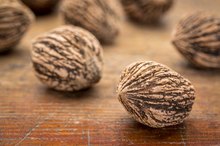Evening Primrose Vs. Black Currant
Evening primrose oil and black currant seed oil are both good sources of the omega-6 fatty acid gamma-linolenic acid, or GLA. Some studies suggest that GLA supplementation may benefit skin, hair and heart health, among other medical conditions. Talk to your doctor to learn more about how evening primrose or black currant seed oil or GLA may help your specific condition.
Background
Evening primrose, or Oenothera biennis, is a plant indigenous to North America with a long history of medicinal use. Women may take evening primrose seed oil to treat menopausal symptoms or use it to ease breast tenderness. However, evening primrose oil is most commonly used to treat skin conditions such as eczema and dermatitis.
Black currant, or Ribes nigrum, is a shrub native to Europe and Asia. The seed oil has been used traditionally as a diuretic, to promote sweating and to reduce fever. Like evening primrose oil, it has been used to treat skin disorders.
- Evening primrose, or Oenothera biennis, is a plant indigenous to North America with a long history of medicinal use.
- However, evening primrose oil is most commonly used to treat skin conditions such as eczema and dermatitis.
Gamma-Linolenic Acid
Borage Oil Side Effects
Learn More
Gamma-linolenic acid is found in the seed oils of both evening primrose and black currant. This omega-6 fatty acid may help to stimulate skin and hair growth, maintain bone health, regulate metabolism and maintain your reproductive system, according to the University of Maryland Medical Center. Gamma-linolenic acid is not an essential fatty that you must obtain from your diet. Instead, your body converts the essential omega-6 fatty acid linoleic into GLA, which in turn is converted into compounds with anti-inflammatory properties. Conversion of linoleic acid into GLA may be deficient in some people, which may cause hypersensitive skin conditions.
- Gamma-linolenic acid is found in the seed oils of both evening primrose and black currant.
- Conversion of linoleic acid into GLA may be deficient in some people, which may cause hypersensitive skin conditions.
Differences
Evening primrose and black currant seed oils can be used in essentially the same manner. The primary difference between these two supplements is the typical GLA content of primrose versus currant. Evening primrose seed oil typically contains 8 to 10 percent total GLA, according to Drugs.com. Black currant seed oil contains 12 to 17 percent GLA, and some black currant seed oils may contain more than 20 percent GLA, according to a report in the Feb. 25, 2004 issue of the “Journal of Agricultural and Food Chemistry.”
- Evening primrose and black currant seed oils can be used in essentially the same manner.
- Black currant seed oil contains 12 to 17 percent GLA, and some black currant seed oils may contain more than 20 percent GLA, according to a report in the Feb. 25, 2004 issue of the “Journal of Agricultural and Food Chemistry.”
Considerations
Side Effects of Frankincense Oil
Learn More
Consult with your doctor if you are considering taking evening primrose or black currant seed oil daily. Allergic reactions are possible in some people. Your doctor may advise against taking these supplements if you are also taking prescription medications such as blood thinners, blood pressure pills or antidepressants. The amount that you take should be tailored to your needs while under medical supervision. Mild side effects of taking too much include intestinal upsets, loose stools and headache. The safety of either oil for pregnant or breastfeeding women has not been well-studied.
- Consult with your doctor if you are considering taking evening primrose or black currant seed oil daily.
- Your doctor may advise against taking these supplements if you are also taking prescription medications such as blood thinners, blood pressure pills or antidepressants.
Related Articles
References
- University of Maryland Medical Center: Gamma-Linolenic Acid
- Drugs.com: Evening Primrose Oil
- Drugs.com: Black Currant
- National Toxicology Program. Evening Primrose Oil (Oenothera biennis L.). Published November 2009
- Mahboubi M. Evening primrose () oil in management of female ailments. J Menopausal Med. 2019;25(2):74-82. doi:10.6118/jmm.18190
- Mehrpooya M, Rabiee S, Larki-harchegani A, et al. A comparative study on the effect of "black cohosh" and "evening primrose oil" on menopausal hot flashes. J Educ Health Promot. 2018;7:36. doi:10.4103/jehp.jehp_81_17
- Harris M, Farrell V, Houtkooper L, Going S, Lohman T. Associations of polyunsaturated fatty acid intake with bone mineral density in postmenopausal women. J Osteoporos. 2015;2015:737521. doi:10.1155/2015/737521
- Khanna S, Jaiswal KS, Gupta B. Managing Rheumatoid Arthritis with Dietary Interventions. Front Nutr. 2017;4:52. doi:10.3389/fnut.2017.00052
- Kruger MC, Coetzer H, De winter R, Gericke G, Van papendorp DH. Calcium, gamma-linolenic acid and eicosapentaenoic acid supplementation in senile osteoporosis. Aging (Milano). 1998;10(5):385-94. doi:10.1007/bf03339885
- Cameron NE, Cotter MA, Dines KC, Robertson S, Cox D. The effects of evening primrose oil on nerve function and capillarization in streptozotocin-diabetic rats: modulation by the cyclo-oxygenase inhibitor flurbiprofen. Br J Pharmacol. 1993;109(4):972-9. doi:10.1111/j.1476-5381.1993.tb13716.x
- Bamford, J.; Ray, S.; Musekiwa, A, et al. Oral evening primrose oil and borage oil for eczema. Cochrane Database Syst Rev. 2013 Apr 30;(4): CD004416. DOI: 10.1002/14651858.CD004416.pub2.
- Cameron, M.; Gagnier, J.; and Chrubasik, S. Herbal therapy for treating rheumatoid arthritis. Cochrane Database Syst Rev. 2011 Feb 16;(2):CD002948. DOI: 10.1002/14651858.CD002948.pub2.
- Farzaneh, F.; Fatehi, S.; Sohrabi, M. et al. The effect of oral evening primrose oil on menopausal hot flashes: a randomized clinical trial. Arch Gynecol Obstet. 2013 Nov;288(5):1075-9. DOI: 10.1007/s00404-013-2852-6.
- Ogbera, A.; Ezeobi, E.; Unachukwa, C. et al. Treatment of diabetes mellitus-associated neuropathy with vitamin E and Eve primrose. Indian J Endocrinol Metab. 2014 Nov-Dec;18(6):846-9. DOI: 10.4103/2230-8210.140270.
Writer Bio
Chad Stone is a medical scientist based in the Pacific Northwest. Since 2003, Dr. Stone has has published high-profile articles on the molecular mechanisms of cardiovascular disease and cancer in journals such as Blood and the Journal of the American Heart Association. Dr. Stone is a specialist in blood biology as well as cancers of breast, colon, kidney and other tissues.









